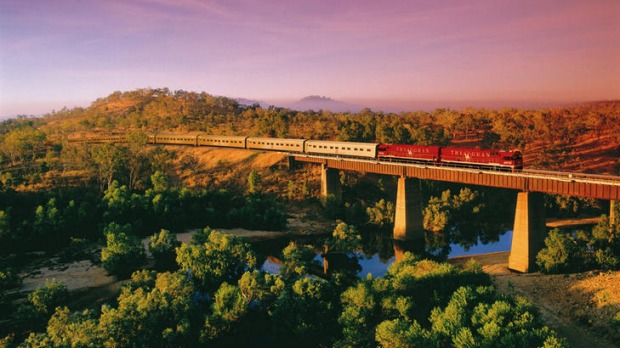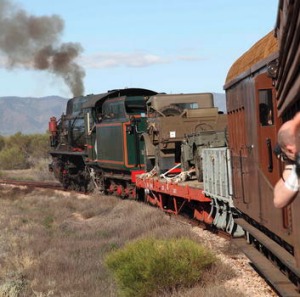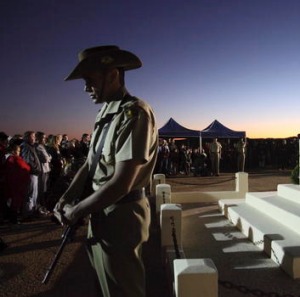
The transcontinental rail journey to Darwin doubles as an emotional Anzac tribute for John Borthwick.
WE'RE way north of Port Augusta, on a trip within a trip. We had left Adelaide on a special Anzac Tribute rail journey on board the Ghan, which is sometimes known as the Legendary Ghan, but at Augusta we change horses for an excursion on the truly legendary, original Ghan. Its wheezing, smoke-belching, lovingly restored steam loco hauls us in old wooden carriages through the Flinders Ranges to Quorn.
Tiny Quorn at the end of the narrow-gauge Pichi Richi heritage line doesn't attract much attention these days but the Ghan train owes Quorn a debt - its very name.

During World War II, thousands of troops en route to Darwin travelled north through the town in the old Ghan, heading for Alice Springs. The good women of the Quorn Country Women's Association served those passing Diggers more than 360,000 meals - and not just in the form of tea and scones.
Well before that, back in 1923, the line ran only as far as Oodnadatta and the service didn't have a particular name. Legend has it that the near-empty train pulled into Quorn at sunset one evening and an Afghan man stepped out to say his prayers. The engine driver joked to several onlookers, "Since he's the only passenger on the train, we'll have to call it The Afghan Express". The name stuck and, as with anything superfluous in the desert, it began to shed syllables. The Afghan Express became the Ghan Express and soon, simply the Ghan.
We head back to Augusta and rejoin our modern Ghan on the new, broad-gauge line that now runs all the way to Darwin. We're on the inaugural Anzac Tribute trip that, coinciding with Anzac Day, commemorates Australia's armed forces. On board alongside the usual passengers are service veterans and others with Anzac connections, plus singer-songwriter John Williamson as our troubadour.

The oldest veteran, Bill Corey, 93, is travelling with his 63-year-old son, Don, also a former soldier. Bill spent five years as an infantryman in serial hellholes, firstly among the Rats of Tobruk in Libya, then in New Guinea and Borneo.
"New Guinea was a terrible place," he recalls, having seen many mates killed there in jungle combat. When his son was conscripted in 1968, Bill gave Don four words of advice: "Don't join the infantry."
An announcement calls us for dinner in the Queen Adelaide restaurant car. The setting is silver service and two chefs, working out of a galley the size of a stretched phone booth, miraculously bring forth delicious offerings such as roasted kangaroo tenderloin and seared fillet of Tasmanian salmon, plus wines to match. After dinner we head to the bar car, where the director of the Darwin Military Museum, historian Dr Tom Lewis, fills in the considerable gaps in our knowledge of Australian war history.
The transcontinental line links whistle-stops in the scrub such as Tarcoola, a hiccup of bricks and tin that was named after - what else but? - the horse that won the Melbourne Cup in 1893.
In 1980, Australian National Railways closed the original Ghan line over which the old service had lumbered so slowly that it was known as "the train you can walk faster than". The two-day journey from Adelaide to Alice Springs sometimes took two weeks or more, thanks to floods and washouts.
Morning comes as a line of low orange fire. We're rolling through one of the flattest, oldest, driest, hottest places on Earth, central Australia but rains fell a few weeks ago and now the desert is lustrous with new growth.
At Manguri, we leave the train to visit the opal town of Coober Pedy, where many servicemen returning from the Great War settled and, ironically, reprised their lives in the trenches of Europe by again digging and living underground.
Our train is three-quarters of a kilometre long, with its 52 cars hauled by two gleaming red diesel locos. The Ghan's 2979-kilometre transcontinental journey from Adelaide to Darwin normally takes two nights and three days but the operator, Great Southern Rail, has added an extra day and night for our commemorative activities. Dawn service on Anzac Hill in Alice Springs is like no other. With the desert sun touching the MacDonnell Ranges, a lone bugler sounds the Last Post in the chill air. The heads of townspeople and travellers alike are bowed in reflection until John Williamson breaks the silence singing the national anthem.
The flag is lowered and wreaths are laid. With the sunrise we head downhill to the Alice Springs RSL Club, where a traditional "gunfire breakfast" is served - think bacon and eggs for a battalion, sluiced down with Bundy-charged coffee.
We rejoin the Ghan and roll on towards the next night. I sleep to the rhythm of the rails in a cabin whose fittings unfold into twin bunks and an en suite bathroom. Outside my window, the sun comes up like thunder across the Never-Never mulga. At Katherine Gorge, we leave the train for a boat cruise along the grand Nitmiluk sandstone channel before Jawoyn Aboriginal dancers perform for us and Williamson sings again. His signature pieces such as Mallee Boy, Raining on the Rock and True Blue ring, similar to Woody Guthrie's anthems, of patriotism without jingoism, national pride without militarism.
The Ghan moves on to Adelaide River, where in a tranquil cemetery 434 Australians killed in Japanese raids are buried in a tropical garden.
We reboard for the final stretch to Darwin, the town that bore the largest-ever attack by a foreign power on Australian soil. Our last pilgrimage is to the Darwin Military Museum, where Australia's wars are recalled not vaingloriously but, as on the train, with a contemplative respect.
Trip notes
Getting there
The 2012 Ghan Anzac Tribute departs Darwin on April 24. The four-day trip takes in Adelaide River War Cemetery, Katherine (Anzac Day dawn service), Alice Springs and a Flinders Ranges excursion in an original troop train. The trip ends at Adelaide on April 27.
Prices per person, twin share, range from $2354 (Red Sleeper) to $2999 (Gold) to $4077 (Platinum). Pensioner fare, $1787; student and children's fares available. Single supplement $850. From every ticket, $100 will be donated to the RSL.
13 21 47, greatsouthernrail.com.au.